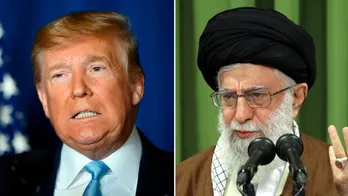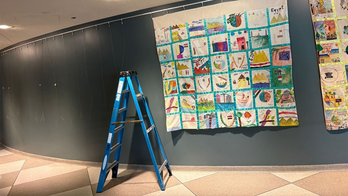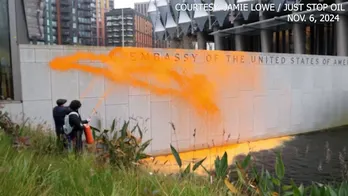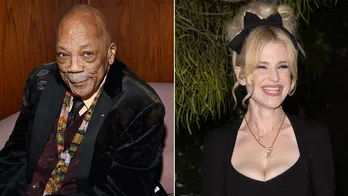Whatever happened to the bird-saving brothers of Oscar-nommed doc 'All that Breathes'?
The tale of two brothers saving hundreds of birds — the carnivorous black kites injured by glass-coated strings on kites flown in the skies of Delhi — was nominated for an Academy Award this year. The film All that Breathes, directed by Shaunak Sen and featuring the bird-saving siblings Nadeem Shehzad and Muhammad Saud, was a critical darling. Even though it didn't garner an Oscar, it won both the Golden Eye award for top documentary in Cannes and the Grand Jury Prize at Sundance in 2022. It's currently available for viewing on HBO and Max.
NPR caught up with the brothers over a video call from their home to find out how their lives have changed since their Oscar run.
Nadeem Shehzad calls the weeks after mid-July "a blood bath." It's an ideal time for kite-flying in Delhi — windy but not too windy. Instead of taking in their usual 10 or so injured birds a day, they contend with as many as 20 to 30.
The birds they save are black kites (named because their brown feathers make them appear to be black as they fly overhead). The brothers have a soft spot for this meat-eating, misunderstood bird from the hawk family. People think of them as vicious hunters but they hunt only when they need to, say the brothers. For the most part, the birds are scavengers, feeding off scraps from slaughterhouses and meat-processing plants that pile up in Delhi garbage dumps. Because they're not considered attractive and feed on rotting flesh, they're an unloved bird. Some people are even scared of them.
At this time of year, the brothers take in bird after bird, their wings torn and bodies bleeding, to the bird hospital they run from their home. There's a reason for the carnage, a scourge with an innocent reputation and an ironic name: the kite. As in, the kind humans play with.
Many people in Delhi engage in a popular kite-fighting game in which they aim to slice through the strings of an opponent's kite. They use the manja, a kite whose cotton or nylon spool thread is coated with shards of powdered glass. The kite-flying craze reaches an annual crescendo when a popular festival kicks off in the capital city on August 15, India's Independence Day; the season lasts till mid-September.
It's a game with lethal consequences, as the glass-covered thread can cut through more than other kite strings. It can slice through flesh and bone – a danger for birds and, occasionally, humans. Earlier this year, a 7-year-old girl riding with her father on a motor scooter got tangled in a stray kite string and died, her throat slit.
For years, the brothers have tried to build awareness about these deadly kites while struggling to save the bird victims. They worked out of their cramped basement, with only one employee, close friend Salik Rehman. In the documentary, the elder of the brothers, Nadeem (who prefers to go by his first name) says poignantly, "Birds are plummeting from the sky. Delhi is a gaping wound and we are a tiny band aid on it." They also rescue birds affected by pollution.
After the success of the documentary, All that Breathes, that band-aid has become a little bigger.
Donations come flying in
"This year, we have more help," says younger brother Saud.
After the documentary was nominated for an Oscar, the producers, Tangled Bank Studios, donated $25,000 to Wildlife Rescue, the non-governmental organization that the brothers have been running since 2010 to fund their work. Other donations poured in from all over the world, leaving the brothers feeling utterly overwhelmed by the kindness of strangers. They've received another $25,000 through small donors alone, says Nadeem. He says 50 to 100 people reach out to him on social media every week, asking how to help. These contributions often take him by surprise, he says, such as the $500 sent by the folks at the Rolling Hills Pet Clinic Hospital in California, urging him to treat his hardworking staff to a night out and dinner. He plans to do so in September, after a busy summer of tending to injured birds.
"I haven't been able to thank everyone who's donated yet. I'm still responding to emails," he says.
The money has been put to use. The brothers have been able to move the bird hospital out of their home and into a single-story building they've rented next door. They've hired four more people, including a veterinarian. The donations not only support the salaries but also help cover the transportation costs for injured birds.
The brothers collect injured kites from five other bird hospitals across Delhi. Those hospitals say they aren't equipped to house and feed carnivorous birds like the kites. So far this year, the brothers say they've saved 2,246 birds — a big jump from the 1,000 or so treated in a typical year.
"Earlier, we'd pick up the birds every alternate day," says Nadeem. Ballooning transport costs meant that they couldn't go every day, and inevitably, some birds would die.
"Now we can hire an uber or autorickshaw for a daily pick up," says Saud. "So we can get to the birds a lot faster for treatment." The brothers say their dream is to have their own dedicated bird ambulance.
During filming, the brothers had a makeshift bird enclosure on the second floor of their home, covered in green mesh. They've now moved the enclosure to the terrace on the third floor and rebuilt it with tiles and stainless steel, making it easier to clean. Blue tin sheets line the roof.
This is a kind of rest stop for birds that have healed and been released, says Nadeem. Every day, nearly 50 kites that they've cared for flit in and out of the area, eating, drinking and resting in the shade. It's a kind of bridge between the hospital and the birds' wild world.
"It's a space where they can get stronger, test their wings before they take flight," says Nadeem.
The brothers have also invested in cameras, scanners, computers to document their rescues.
A deferred dream
At the end of the documentary, Nadeem was preparing to study veterinary science in the U.S. He was accepted at a private university in North Carolina but wasn't able to go because his $5,000 scholarship would only cover 10% of the costs. "It's always been a dream to study in the U.S.," he says.
He still hopes to get formal scientific training to supplement the knowledge he and his brother have gained on their own. For example, the manja kite strings cause such deep and complex wounds to birds' wings that some can never fly again. Many veterinarians told them that these wounds simply cannot heal completely. However, Nadeem says they've devised their own technique for aligning muscle, bone and tissue. They have photographed and documented how many of the birds they have treated, even those with the worst of injuries, were able to fly again. Nadeem hopes to embark on research and share his knowledge with the wider community of veterinarians and rescuers.
A flutter of hope
The brothers say the birds they can't save weigh heavily on their minds, but they take heart that they can help with most injuries.
It's a sentiment that many wildlife rescuers are familiar with, says Dr. Ulrike Streicher, rehabilitation director and veterinarian at the Cascades Raptor Center in Oregon. When the film was shown at the annual National Wildlife Rehabilitators Symposium in March 2023, she says, many in the audience felt the brothers' pains and struggles very strongly. "It is a tough crowd — people who see sad, heartbreaking and horrifying things every day," says Streicher. "Seeing that [the brothers] did this work under such very limited conditions and in the face of political and social unrest and insecurity brought them to tears," she says.
Today, the brothers' children are beginning to take an interest in their rescue work. Nadeem's daughter, Inayaa, is 6. Saud has an 8-year-old son named Aalif and a daughter, Zara, who is almost 2. The girls love birds, Nadeem says.
Aalif appears in the documentary, and after the Oscars ceremony he received a special award from school for helping his dad and uncle. Saud says his son was enormously proud. "It meant more to him than the Oscars."
Kamala Thiagarajan is a freelance journalist based in Madurai, Southern India. She reports on global health, science, and development, and her work has been published in the New York Times, The British Medical Journal, BBC, The Guardian and other outlets. You can find her on twitter @kamal_t
Disclaimer: The copyright of this article belongs to the original author. Reposting this article is solely for the purpose of information dissemination and does not constitute any investment advice. If there is any infringement, please contact us immediately. We will make corrections or deletions as necessary. Thank you.







